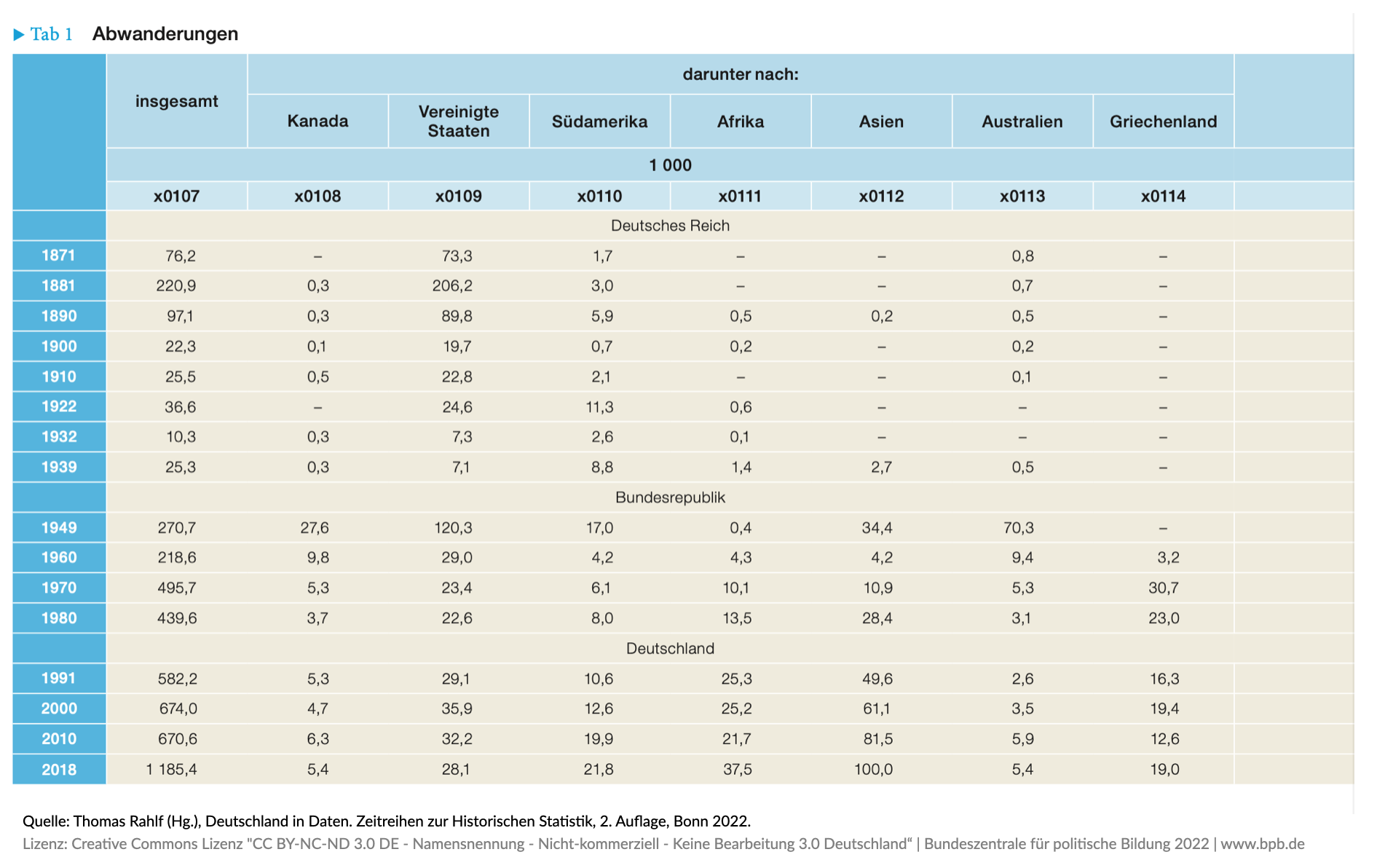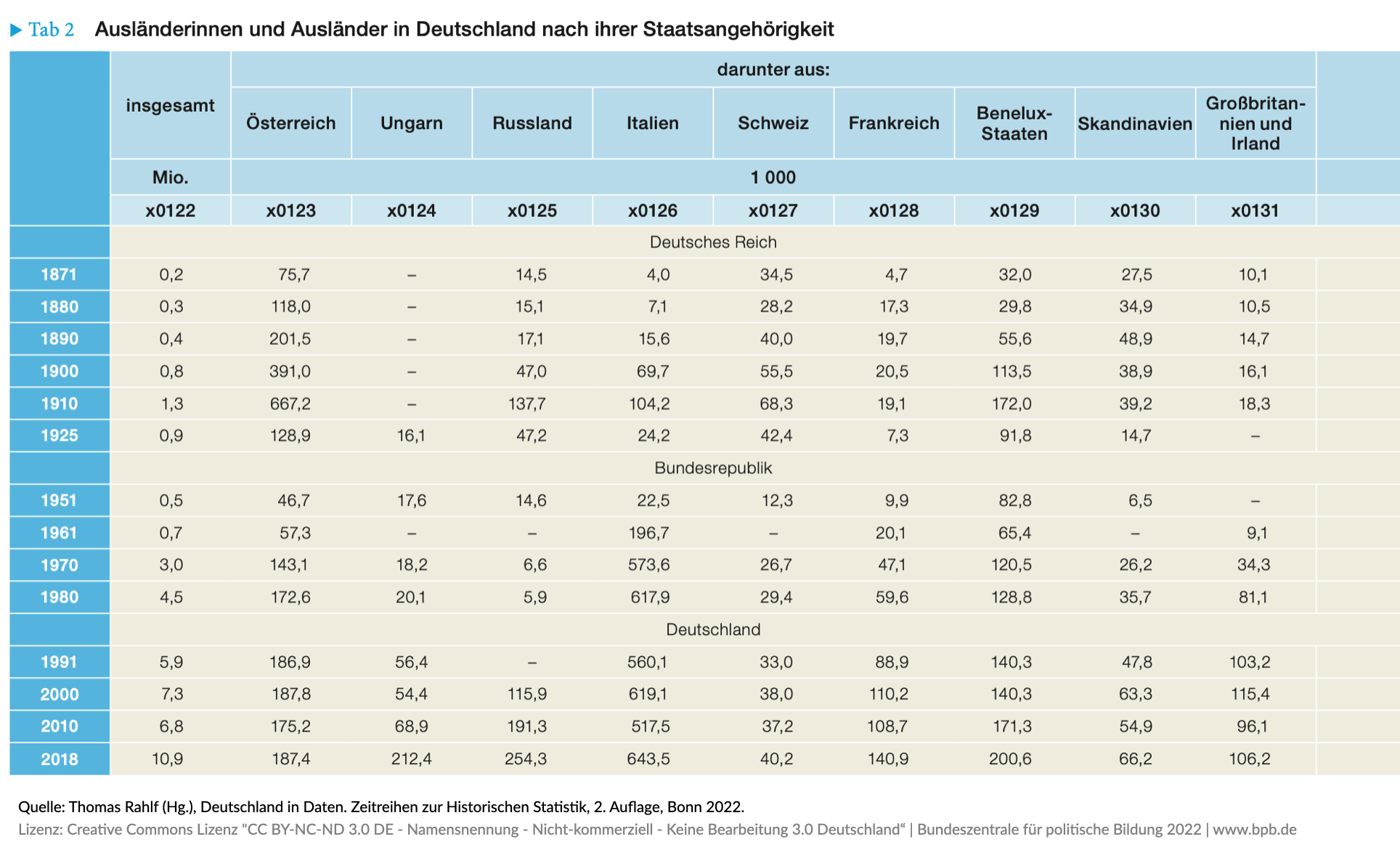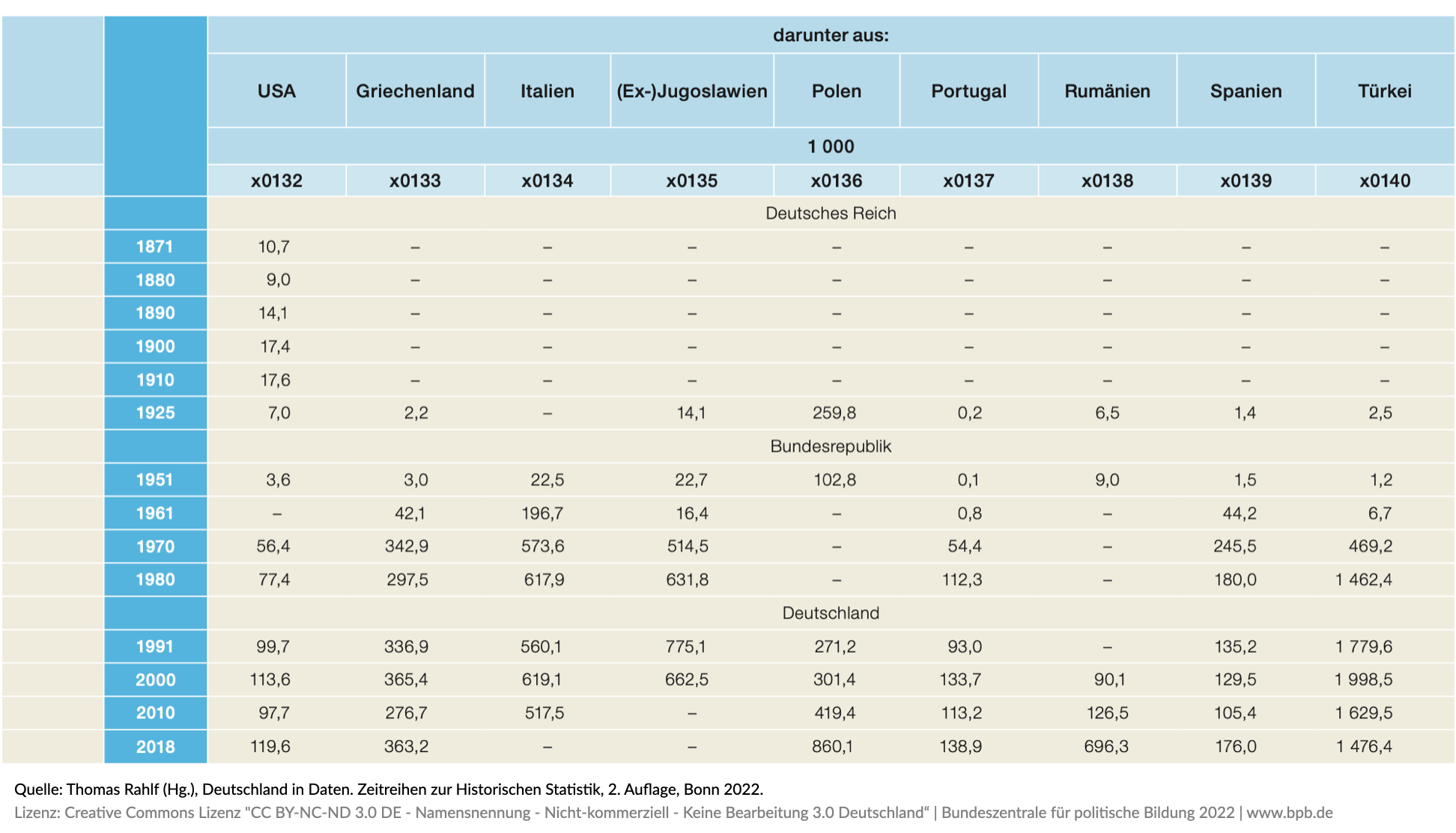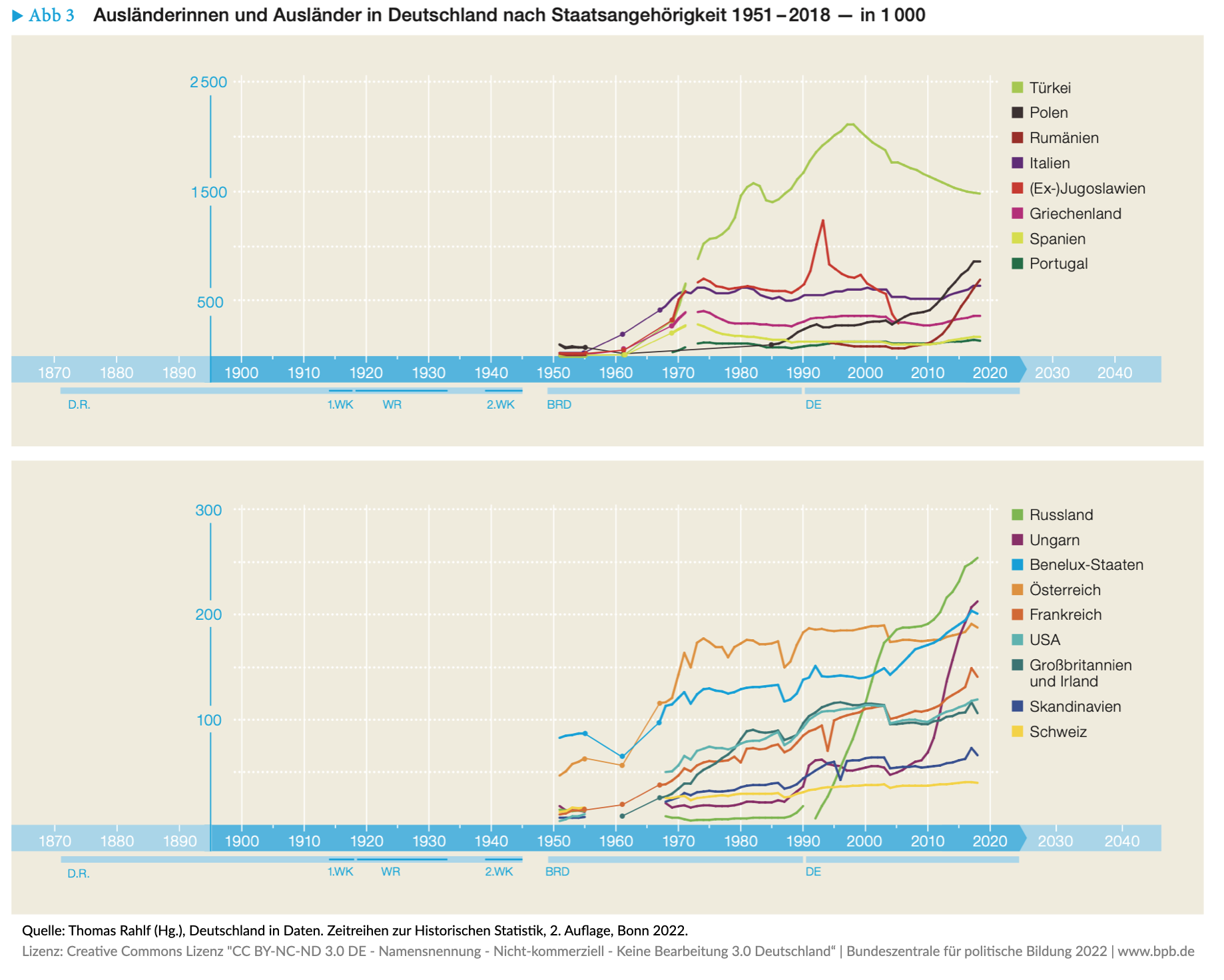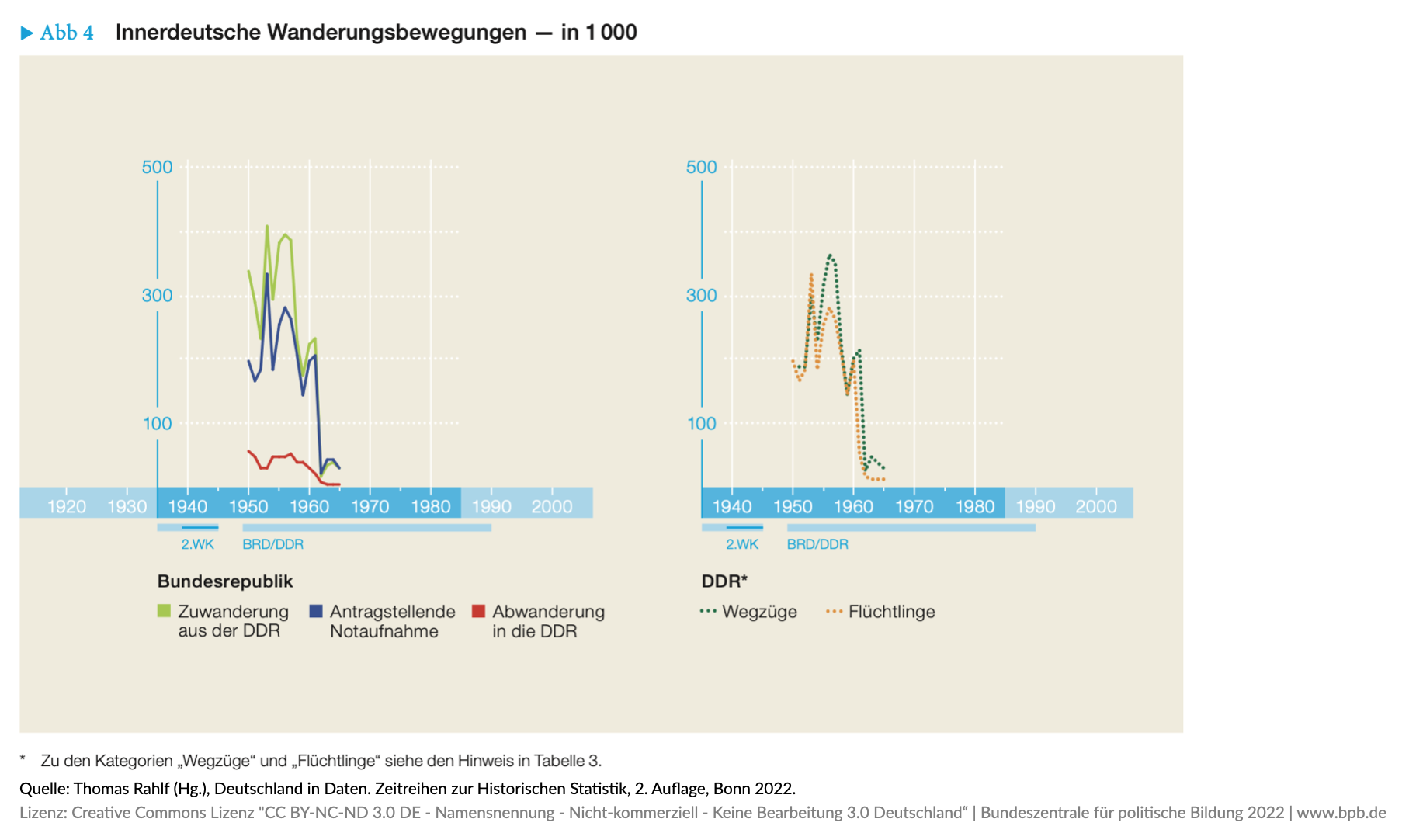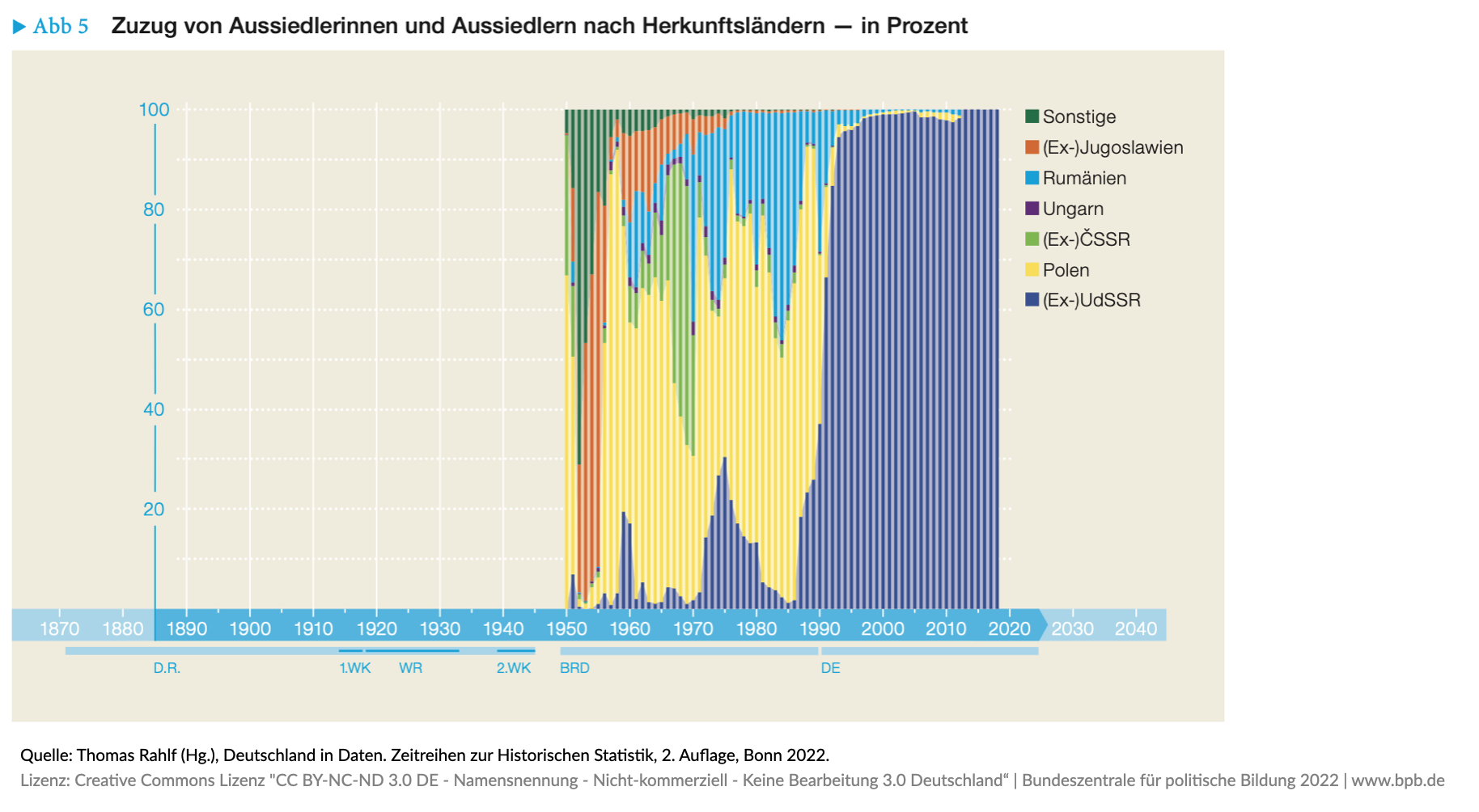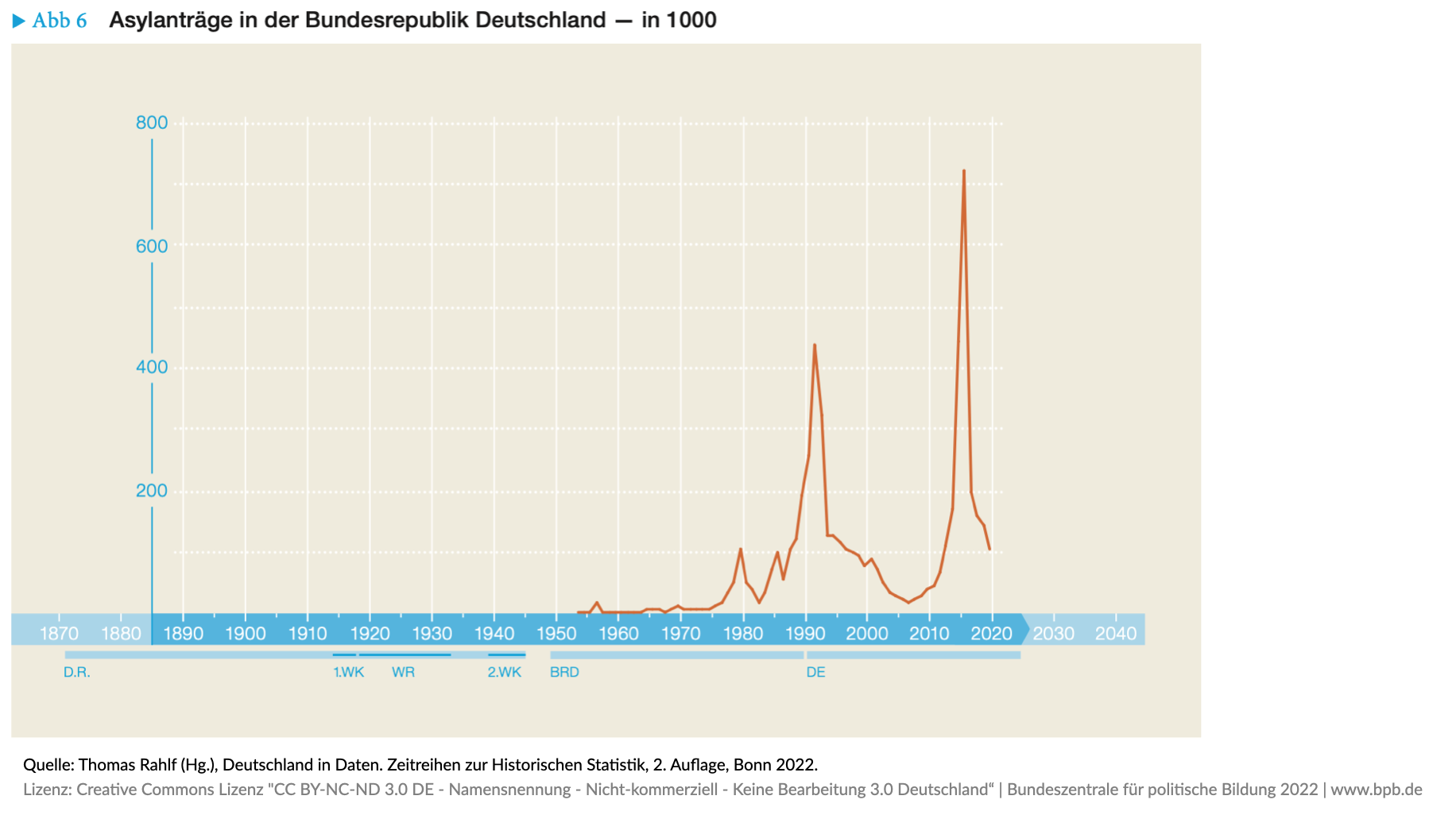Jochen Oltmer
University of Osnabrück
English translation of: Jochen Oltmer, Migration, in: Thomas Rahlf (Ed.), Deutschland in Daten. Zeitreihen zur Historischen Statistik, Bonn: Bundeszentrale für politische Bildung 2015, pp. 46-58.
Citation
Jochen Oltmer, Migration, in: www.deutschland-in-daten.de, 01.03.2016 < http://www.deutschland-in-daten.de/en/migration >.
Copyright (c) 2016 by Deutschland in Daten, and the author, all rights reserved. This work may be copied and redistributed for non-commercial, educational purposes, if permission is granted by the author and usage right holders. For permission please contact kontakt@deutschland-in-daten.de.
Introduction
Migration can be understood as a long-term shift in the geographical centre of people’s lives, affecting individuals, families, groups or even whole populations. From a political, statistical and journalistic viewpoint, migrations have been the object of particularly intensive observation when state borders have been crossed. Migration studies, however, usually refers to a broader concept of migration, encompassing not only cross-border movements, but also interregional and intraregional movements within national territories. These movements can have considerable importance for social, economic, political and cultural development.1
In the migration history of Germany in the 19th, 20th and early 21st centuries, five distinctive and fundamental processes can be identified:2
1. From the early 19th century to the 1890s, the dominant phenomenon was the transatlantic mass emigration of Germans, of whom more than 90 per cent reached the United States of America.
2. In the 19th century, industrialization, urbanization and agricultural modernization led to a fundamental change in migration patterns: new, rapidly emerging industrial-urban centres now offered employment opportunities to the urban and rural labouring classes, but also to the (new) middle classes. These opportunities led to millions of internal and cross-border migrations.
3. The fundamental restructuring of statehood in the 19th century resulted in various changes in the underlying conditions for migration and integration, with far-reaching consequences in the 20th century. At the end of the 19th century, nation-building – designed to underpin the legitimacy of state rule – interacted with colonial and imperial ambitions, and with the establishment and expansion of the interventionist and welfare state, which was in itself a response to mass politicization and to the increasing organization of political interests. This combination of factors caused governments to notice cross-border and internal migration and immigrant groups in new and different ways. In some cases this led to the establishment of legal and administrative entry barriers for those groups seen as having a high degree of foreignness, while also leading to the opening of privileged access routes for other groups, those that were regarded as part of the same nation. At the same time, the considerable expansion of the state’s capacity to intervene and impose order made it possible for ideas about migration policy to be implemented.
4. The two world wars of the 20th century and their political consequences led to an enormous increase in forced migrations. These included deportation and forced labour in the war economies, evacuation and flight from the battle zones, and mass expulsions after the end of the wars. Germany was a centre of European forced migration processes both during and after the First World War and during and after the Second World War.
5. The migration patterns in the Federal Republic of Germany are an example of the establishment of a new migration regime in constitutional and welfare states since the mid-20th century. In the 1950s, in a situation of high economic growth, intergovernmental recruitment agreements facilitated the large-scale admission of foreign workers. As the length of the workers’ stay increased, their residency status gradually became more secure. At the same time, this reduced the state’s power to stop processes of long-term settlement and follow-on migration, even after the end of the recruitment phase in 1973. In the GDR, where employment of foreigners was much lower, permanent immigration and integration were generally prevented. After the opening of the borders in 1989/90, East-West migration, which had been kept to a minimum during the “Cold War”, became much more significant again; to some extent, the European migration patterns that had existed before the Second World War now re-emerged.
This article begins by looking at how emigration from Germany developed from the early 19th century to the present. It then discusses aspects of the development of immigration into Germany, looking at data on foreign nationals in Germany and on the numbers of people moving to Germany since the end of the 1940s. This is discussed in greater depth with sections on the migratory movements between East and West Germany, the immigration of ethnic German resettlers (Aussiedler), and that of refugees who have sought asylum in the Federal Republic of Germany since the beginning of the 1950s.
Transatlantic emigration
Like all states, Germany has always been a migratory hub, with different movements constantly passing through it, as well as both a starting point and a destination for migratory movements. Thus descriptions of Germany as a “country of emigration” or “country of immigration” merely point to a predominant direction in the development of migration processes, but never indicate that there was only one direction. In 19th-century Germany, emigration was the main direction.
It is likely that almost 6 million Germans moved overseas between 1841 and 1928, the vast majority destined for the US.3 Next on the list, but far behind, were Canada, Brazil, Argentina and Australia. The reason behind this huge emigration movement was the disparity between major growth in the German population on the one hand, and a much slower increase in jobs in Germany on the other – as well as an apparently attractive range of opportunities in overseas destinations (especially in North America). Beginning in the 1830s, German transatlantic migration rapidly turned into a mass movement. Two peak phases saw more than 1 million emigrants each: 1846 to 1857 and 1864 to 1873. In the last major phase of emigration between 1880 and 1893, another 1.8 million followed. Between 1820 and 1860, the German-born population in the US was the second-largest immigrant group after the Irish, at 30 per cent, and from 1861 to 1890 Germans constituted the largest immigrant group.4
In the late 19th century, the considerable expansion of economic opportunities in Germany, thanks to advanced industrialization and agricultural modernization, constituted key factors in the decline of overseas emigration. This trend was accelerated by the severe economic crisis in the US from 1890 to 1896, culminating in the panic of 1893. 1893 was the last year of substantial transatlantic emigration from Germany before the First World War. After the end of the war, transatlantic migration rose to a new high: between 1919 and 1932, a total of around 600,000 Germans moved overseas. The United States of America continued to be the main destination, with about 71 per cent, followed at a considerable distance by Argentina, Australia, Brazil and Canada. Emigration from the Weimar Republic peaked in the years 1920 to 1923, with the highest level in the “year of crisis” of 1923. The annual total for that year, 115,000 emigrants, was the highest to have been seen since the last big wave of emigration in the 19th century, from 1880–1893.5 In the one-and-a-half decades between 1946 and 1961, lastly, a total of just under 780,000 Germans moved overseas temporarily or permanently. 384,700 were destined for the United States, 234,300 for Canada, and 80,500 for Australia. This was the largest emigration movement from Germany in the 20th century.6
As the data available for the development of emigration in West Germany/the Federal Republic after 1945 has a different basis to that available for overseas emigration before 1939, it is not possible to directly compare these figures. The figures for German emigration in the 19th and early 20th century give the impression that there was a constant, linear movement from Germany abroad. What remains invisible here is the sizeable proportion of transatlantic migrants who returned to Germany (probably around 20 per cent), and the trend towards circular movements of multiple departures and returns, which became more significant from the late 19th century onwards.7 The data about departures for the period from 1945 is much more useful for assessing the dynamics of migratory movements, with their high fluctuation. While the data for the 1950s still strongly indicates emigration by Germans, the much higher figures from the 1960s are largely due to the departure of foreign nationals who had moved to West Germany in the context of the increased employment of foreigners. Substantial immigration of foreign workers, such as took place in the late 1960s and early 1970s, resulted in substantial emigration, and the rapid increase in immigration after the opening of the “Iron Curtain” in 1989/90 led simultaneously to a sharp rise in emigration.8
Immigration to Germany and Foreigners in Germany by nationality
From the late 19th century, immigration outweighed emigration in German migration history. For the German Empire and the Weimar Republic, this is shown by census data. The censuses between 1871 and 1910 offer the advantage of indicating the number of foreigners (classed by nationality) living in a defined territory at a set date (1 December), at regular five-year intervals, based on standardized criteria. The chosen census date, however, had one substantial disadvantage: it was outside the season for weather-dependent activities, in which the vast majority of the hundreds of thousands of foreign labour migrants in the German Reich were employed (especially in agriculture, civil engineering and construction-related industries). As a result, these workers could not appear in the statistics.9 The data for the interwar period is limited to the two censuses of 1925 and 1933, which were taken on different census dates (1925: June, 1933: December).
Between 1871 and 1910, fundamental changes in the presence of foreign nationals in Germany can be identified. In the first decade of the Reich their numbers remained low, at 200,000 to 300,000, but from the 1890s they rose considerably. The reason behind this was the economic boom in the three decades preceding the First World War, which not only largely halted the overseas emigration of Germans, as mentioned above, but also attracted workers from other countries because of the growing opportunities for employment. After the First World War the number of foreigners in Germany decreased, not least due to the much less favourable economic situation.10
In the 1950s, the population within the territory of the Federal Republic of Germany included relatively few foreign nationals, around 400,000 to 500,000. In large part these were people who had come to Germany around the time of the Second World War as forced labourers, prisoners of war, or refugees, and remained there, at least temporarily, as “displaced persons” or Heimatlose Ausländer. It was only with the high growth rates and full employment of the 1950s Wirtschaftswunder, and with the rapid drop in immigration from the GDR after the construction of the Berlin Wall in 1961 (see below), that the employment of foreign workers (Gastarbeiter or “guest workers”) increased substantially in the 1960s and early 1970s. Against this background, the number of foreign nationals reached its first peak of 4.1 million in 1974. The end of the recruitment of foreign workers with the Anwerbestopp (recruitment stop or recruitment ban) of 1973 did not lead to a significant decline in the number of foreign nationals. Instead the number started to rise moderately again in the 1980s, particularly because it was still possible for the families of foreign nationals to follow them to Germany, and also because of the increasing importance of asylum-related migration (see below). Another sharp rise began with the collapse of the political systems in Eastern, East-Central and Southeastern Europe, and the opening of the “Iron Curtain”, in 1989/90. Since the late 1990s the number of foreign nationals has remained fairly stable, with a tendency to fall, which can be explained in part by the considerably easier access to German citizenship following the reform of the citizenship laws in 2000.11
In comparison to the composition of the foreign population in the German Empire, fundamental changes can be identified. While the dominant countries of origin in the earlier period were Austria-Hungary, Tsarist Russia, the Netherlands and Italy, the majority of foreign nationals in the Federal Republic from the 1960s onwards came from those countries with which West Germany had signed recruitment agreements: mainly Turkey, Italy, Spain and Greece. Later, especially from the late 1980s, foreign nationals from a wider range of countries began to arrive. This was a result of both the above-mentioned opening of the “Iron Curtain”, and increasing (asylum-based) immigration from all over the world – though immigration from Europe still predominated.
Migration movements within Germany
The end of the Second World War led to a huge increase in migratory movements in Europe. On the one hand, the refugees, evacuees, expellees, deportees and prisoners of war who had been forced to migrate during the war were returning home; on the other hand, the efforts of the victors to homogenize the populations of their (in some cases newly won) territory resulted in expulsion, resettlement, displacement and flight, especially of minorities. This also affected around 14 million Germans, who left or were forced to leave East-Central, Eastern and Southeastern Europe in the final phase of the war or in the early post-war years. Also of great significance for the development of German migration patterns after the Second World War were the movements between the Soviet Occupation Zone (or since 1949: GDR) and the Western Zones (or since 1949: FRG) between 1945 and 1989/90.
The inner-German border was already largely secured in 1952/53, considerably obstructing movement from East to West or from West to East Germany. For many years, however, the special status of Berlin did not allow any border security measures between the allied sectors of the former capital of the Reich. This meant that the GDR and the USSR had little means to control and block emigration, and it is likely that over 3 million people migrated from East to West Germany between the founding of the two German states in 1949 and the construction of the Wall in 1961 (as well as more than 500,000 in the opposite direction).12 While the number of Germans who moved from West to East Germany in the 1950s was not subject to any great fluctuations and came to around 50,000 per year, the margins of fluctuation in East-West movements were considerably higher: according to data from the Notaufnahmeverfahren (emergency admission procedure), the annual figures in the 1950s oscillated between around 150,000 and 330,000. The numbers were highest in 1953 and in 1956/57. After a minimum in 1959, the numbers rose markedly again until the Wall was built, not least because of a reintensification of the policy of collectivization.
The construction of the Wall massively reduced movement between East and West Germany: the number of people migrating from West to East Germany from the 1960s to the 1980s did not exceed a figure of 5,000 per year, and was usually around 2,000 to 3,000 per year, with relatively little fluctuation. Emigration from East Germany in the late 1960s, the 1970s and the early 1980s came to around 13,000 to 20,000 people per year. This figure did not rise substantially again until the final phase of the GDR, reaching a peak level of over 40,000 in 1984 (after the billion-mark loan to the GDR and the approval of 32,000 exit visas, with the aim of calming the domestic political situation). In 1989, the year the Wall fell, the number of people applying for emergency admission rose to over 340,000. From the construction of the Wall until the end of 1988, a total of over 600,000 people found their way from East Germany to West Germany. The vast majority of these were able to cross the border on the basis of exit permits, which were granted relatively readily to pensioners and other non-working people. The number of members of the working population who were permitted to leave the GDR, and of those who successfully crossed the border by irregular channels, remained very low in comparison.
Asylum Seekers and Refugees
Asylum is used to refer to the reception and protection of a political refugee with foreign citizenship. The reception of refugees has become a more significant factor in the migration situation in the Federal Republic since the late 1970s. In the late 1980s and early 1990s in particular, it contributed greatly to an increase in the number of foreign nationals. The data about the number of asylum seekers in the Federal Republic since 1950 is based on official statistics, and refers to those refugees who have applied for asylum in accordance with the provisions of Article 16, paragraph 2, sentence 2 of the Basic Law of the Federal Republic of Germany. Other categories of refugee (especially “quota refugees” or “resettlement refugees”, who have been admitted on the basis of humanitarian campaigns, without having to apply for asylum) are not included here. It should be borne in mind that only a small proportion of asylum applications were approved, so the majority of these did not lead to long-term or permanent residence in the Federal Republic.
In the 20 years from the founding of the state in 1949 until 1968, only just over 70,000 people sought asylum in the Federal Republic. In the first thirty years of the state’s existence, the annual numbers of asylum seekers fluctuated between a minimum of around 2,000 in 1953 and a maximum of around 51,000 in 1979. Right up to the 1960s, by far the most asylum seekers came from Eastern, East-Central and Southeastern Europe: the proportion of asylum seekers from the “Eastern Bloc” each year fluctuated between 72 and 94 per cent. In the last third of the 1970s, the statistical curve of asylum applications in West Germany began to rise steeply: in 1978 applications were made for 33,136 people, in 1979 it was 51,493 people, and in 1980 the numbers peaked at 107,818. At the same time, the proportion of applicants from outside Europe increased.13
After a brief decline, the level of asylum-based immigration began to rise again in the mid-1980s, mainly reflecting the political and economic crisis in Eastern, East-Central and Southeastern Europe, the opening of the “Iron Curtain”, and the civil war in (Ex-)Yugoslavia in the 1990s. The number of asylum seekers exceeded 100,000 again in 1988, rose to around 190,000 in 1990, and finally reached a peak of nearly 440,000 in 1992. At the same time, the composition of the group of asylum seekers changed radically: in 1986, around 75 per cent were still from the “Third World”, but in 1993, 72 per cent were once again from Europe. The higher the number of people claiming the right to asylum in the Federal Republic from the 1970s onwards, the more legislative measures and provisions were introduced to restrict this right. Such legal regulations, especially the limiting of access to asylum by means of a change in the constitutional right to asylum in 1993, contributed to a sharp decline in asylum-based immigration from the mid-1990s.14
Ethnic German resettlers (Aussiedler)
The term Aussiedler has its origins in the early 1950s. After the expulsions of Germans from Eastern, East-Central and Southeastern Europe had ended, there were still around 4 million “deutsche Volkszugehörige” (“ethnic Germans”) without German citizenship living in these areas, according to information from German agencies in 1950. The Basic Law of the Federal Republic of Germany (Article 116, paragraph 1) guaranteed them admission as German citizens if they could prove a “Vertreibungsschicksal” (“fate of expulsion”), or if the German authorities had seen signs of “Vertreibungsdruck” (“expulsion pressure”). The framework and conditions for their admission were regulated by the 1953 “Gesetz über die Angelegenheiten der Vertriebenen und Flüchtlinge” (“Law on the Affairs of Expellees and Refugees”), usually abbreviated to Bundesvertriebenengesetz (Federal Expellee Law) or BVFG. In the six decades from 1950 to 2015, a total of more than 4.5 million ethnic German resettlers moved to the Federal Republic of Germany.15
From 1950 to 1975, around 800,000 resettlers passed through the West German border transit camps; from 1976 to 1987 the number was around 616,000. Over this period, their numbers fluctuated between 20,000 and 60,000 per year. Efforts to build communication and understanding in the context of West Germany’s “new Ostpolitik”, along with the “détente” in the “Cold War”, led to a phase of steady and relatively high resettler immigration beginning in the early to mid-1970s. In the 1970s and 1980s the most important country of origin was Poland: in a 1975 agreement between Poland and the Federal Republic, Poland promised to allow the departure of around 125,000 resettlers in exchange for a loan of 2.3 billion DM. From the end of the 1970s, the number of resettlers from Romania also increased, again on the basis of financial contributions from the Federal Republic. Between 1950 and 1987, 62 per cent of all ethnic German resettlers came from Poland, the main country of origin (848,000), and only 8 per cent (110,000) from the Soviet Union, which continued to impose tight emigration restrictions. In second place to Poland, and well ahead of the USSR, was Romania, with 15 per cent of all Aussiedler (206,000).
The mass immigration of ethnic German resettlers began with the collapse of the political systems in Eastern, East-Central and Southeastern Europe and the opening of the “Iron Curtain”: from 1987 onwards, the numbers of resettlers, mainly from the USSR, rose steeply. Annual immigration by resettlers rose to just over the 200,000 mark in 1988, and hit nearly 400,000 in 1990. In 1991, despite high numbers of applications, it fell substantially to a little over 200,000, and remained at this high level until 1995, after which it dropped sharply. The major decrease after 1990 was due in part to legislative measures by the Federal Republic, which made it considerably harder to claim resettler status, but also to the fact that fewer and fewer people in Eastern, East-Central and Southeastern Europe could invoke “German ethnicity” and “expulsion pressure”. Since the beginning of the 21st century, this migratory movement has dwindled to insignificance, with just a few thousand immigrants per year.
Data sources:
Data on the different forms of migration and migratory movements has been and still is gathered extensively. However, long series of data can only be found for a very small number of contexts. The statistical series brought together for this article refer to cross-border movements, and document both immigration and emigration. Because of the difficulty of accessing data for the 19th and early 20th century, more emphasis is given to the phase after the Second World War.
The documentation of the long-term development of cross-border emigration from Germany is based on different sets of information. The figures for the period from 1834 to 1870 are taken from data collated in 1930 by Friedrich Burgdörfer, then head of the department of population statistics in the Reich’s Statistics Office. They are based on a comparison between US immigration statistics and data on German transatlantic emigration via Hamburg and Bremen. The figures for the period from 1871 to 1939 come from the official emigration statistics of the German Reich. This included emigrant counts in Germany’s international ports, sometimes supplemented with reports on overseas emigration by Germans from major ports in other European countries (the Netherlands, France, Italy, Great Britain) – though these by no means gave a complete picture. Thus the data for the period from 1834 to 1939 does not provide information about total emigration from Germany, as it completely disregards the movement of Germans within Europe, and only covers transatlantic migration – with certain gaps. The data gathered in later years, for the period from 1946, is quite different in nature: it documents all the officially recorded long-term/permanent departures (across the West German/Federal German borders) of both Germans and foreigners living in Germany, and thus uses a much broader definition of emigration than the information available here for the 19th and early 20th century.
The long-term development of immigration can be documented by means of the number of foreign nationals living in the German Reich, as recorded in the censuses taken between 1871 and 1933. An additional source is the annual information of the Federal German Central Register of Foreigners for the period from 1951. It records all the foreign nationals in the Federal Republic who hold a residence permit or have applied for asylum. Official statistics about the number of people moving to the Federal Republic of Germany have also been used.
The data compiled here on post-1945 migratory movements within Germany is based on various records. Some of the figures come from official population registers, recording arrivals and departures, some are based on information from the emergency admission procedure introduced in West Germany in 1950. This limited the freedom of movement of immigrants from East Germany, while granting them, under certain conditions, refugee status with corresponding benefits. It did not, however, cover those who could not or did not wish to claim any benefits, and who travelled directly to relatives or acquaintances in West Germany.
Information about the number of migrants in the Federal Republic admitted as ethnic German resettlers or asylum seekers is provided by official statistics.
Suggestions for further reading:
Klaus J. Bade: Migration in European History, Malden, MD 2003.
Klaus J. Bade/Pieter C. Emmer/Leo Lucassen/Jochen Oltmer (eds.): The Encyclopedia of Migration and Minorities in Europe: From the Seventeenth Century to the Present, 2rd edn., Cambridge: Cambridge University Press 2013.
Klaus J. Bade/Jochen Oltmer: Normalfall Migration, Bonn 2003.
Helge Heidemeyer: Flucht und Zuwanderung aus der SBZ/DDR 1945/1949–1961. Die Flüchtlingspolitik der Bundesrepublik Deutschland bis zum Bau der Berliner Mauer, Düsseldorf 1994
Ulrich Herbert: Geschichte der Ausländerpolitik in Deutschland. Saisonarbeiter, Zwangsarbeiter, Gastarbeiter, Flüchtlinge, Munich 2001.
Dirk Hoerder: Deutsche Migrationen. Vom Mittelalter bis heute, Munich 2011.
Jochen Oltmer: Migration im 19. und 20. Jahrhundert, 2nd edn., Munich 2013.
Notes
- For reflections on the definition of the subject and its manifestations, see Jochen Oltmer: Globale Migration. Geschichte und Gegenwart, Munich 2012, pp. 14–32. Notes will be kept to a minimum in the following discussion.
- For more detail on this, see Jochen Oltmer: Migration im 19. und 20. Jahrhundert (Enzyklopädie deutscher Geschichte, vol. 86), 2nd edn., Munich 2013.
- Friedrich Burgdörfer: Die Wanderungen über die deutschen Reichsgrenzen im letzten Jahrhundert, in: Allgemeines Statistisches Archiv, 20 (1930), pp. 161–196, 383–419, 537–551.
- For an overview see Klaus J. Bade: Die deutsche überseeische Massenauswanderung im 19. und frühen 20. Jahrhundert: Bestimmungsfaktoren und Entwicklungsbedingungen, in: Klaus J. Bade (ed.), Auswanderer – Wanderarbeiter – Gastarbeiter. Bevölkerung, Arbeitsmarkt und Wanderung in Deutschland seit der Mitte des 19. Jahrhundert, 2nd edn., Ostfildern 1985, pp. 259–299; Walter D. Kamphoefner: Westfalen in der Neuen Welt. Eine Sozialgeschichte der Auswanderung im 19. Jahrhundert, Göttingen 2006.
- Hartmut Bickelmann: Deutsche Überseeauswanderung in der Weimarer Zeit, Wiesbaden 1980.
- Alexander Freund: Aufbrüche nach dem Zusammenbruch. Die deutsche Nordamerika-Auswanderung nach dem Zweiten Weltkrieg, Göttingen 2004; Jan Philipp Sternberg: Auswanderungsland Bundesrepublik. Politische und mediale Wahrnehmung in Deutschland 1945–2010, Paderborn 2012.
- Karen Schniedewind: Begrenzter Aufenthalt im Land der unbegrenzten Möglichkeiten. Bremer Rückwanderer aus Amerika 1850–1914, Bremen 1991.
- See articles in: Jochen Oltmer/Axel Kreienbrink/Carlos Sanz Díaz (eds.): Das „Gastarbeiter“-System. Arbeitsmigration und ihre Folgen in der Bundesrepublik Deutschland und Westeuropa, Munich 2012.
- Klaus J. Bade: „Preußengänger“ und „Abwehrpolitik“: Ausländerbeschäftigung, Ausländerpolitik und Ausländerkontrolle auf dem Arbeitsmarkt in Preußen vor dem Ersten Weltkrieg, in: Archiv für Sozialgeschichte, 24 (1984), pp. 91–162.
- Jochen Oltmer: Migration und Politik in der Weimarer Republik, pp. 398–419.
- For an overview see: Klaus J. Bade/Jochen Oltmer: Normalfall Migration, Bonn 2003, pp. 98–105.
- For more on this and the following points see: Helge Heidemeyer: Flucht und Zuwanderung aus der SBZ/DDR 1945/1949–1961, Düsseldorf 1994; Volker Ackermann: Der „echte“ Flüchtling. Deutsche Vertriebene und Flüchtlinge aus der DDR 1945–1961, Osnabrück 1995; Andrea Schmelz: Migration und Politik im geteilten Deutschland während des Kalten Krieges. Die West-Ost-Migration in die DDR in den 1950er und 1960er Jahren, Opladen 2002; Damian van Melis/Henrik Bispinck (eds.): „Republikflucht“. Flucht und Abwanderung aus der SBZ/DDR 1945 bis 1961, Munich 2006.
- Patrice G. Poutrus: Zuflucht im Nachkriegsdeutschland. Politik und Praxis der Flüchtlingsaufnahme in Bundesrepublik und DDR von den späten 1940er bis zu den 1970er Jahren, in: Ute Frevert/Jochen Oltmer (eds.): Europäische Migrationsregime. Special issue of Geschichte und Gesellschaft, (35) 2009, 1, pp. 135–175.
- Ursula Münch: Asylpolitik in der Bundesrepublik Deutschland, 2nd edn., Opladen 1993; Bade/Oltmer, Normalfall Migration (note 12), pp. 106–117.
- For more on this and the following points, see: Klaus J. Bade/Jochen Oltmer: Einführung: Aussiedlerzuwanderung und Aussiedlerintegration. Historische Entwicklung und aktuelle Probleme, in: Bade/Oltmer (eds.): Aussiedler: deutsche Einwanderer aus Osteuropa, 2nd edn., Göttingen 2003, pp. 9–51; Jannis Panagiotidis: Staat, Zivilgesellschaft und Aussiedlermigration 1950–1989, in: Jochen Oltmer (ed.), Handbuch Staat und Migration in Deutschland seit dem 17. Jahrhundert, Berlin/Boston 2016, pp. 895–929.
